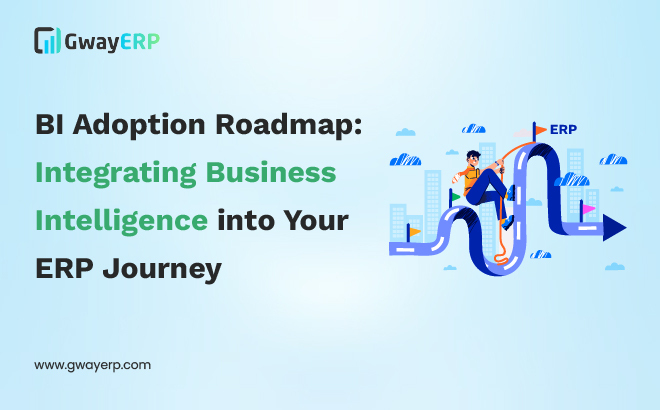
Introduction
The importance of Business Intelligence (BI) in enhancing Enterprise Resource Planning (ERP) functionality cannot be overlooked.
ERP systems serve as the backbone of organizations, providing a centralized platform for managing various business processes.
However, the integration of BI software seamlessly into ERP environments requires a well-defined adoption roadmap.
In this article, we will delve into the intricacies of integrating BI into your ERP journey, highlighting its benefits, strategies, and potential challenges.
I. Understanding Business Intelligence Software in the ERP Context
1. Defining BI Software: Exploring the functionalities of Business Intelligence software in the context of ERP systems.
Business Intelligence software refers to a set of tools and technologies that enable organizations to gather, analyze, and interpret raw data to make informed decisions.
In the context of ERP systems, BI software acts as a valuable extension, providing advanced analytics capabilities to extract actionable insights from the vast amounts of data generated within the ERP ecosystem.
These insights empower decision-makers by transforming data into meaningful information.
2. Benefits of BI in ERP: Highlighting how BI enhances decision-making, data analysis, and overall efficiency in ERP environments.
The integration of BI software into ERP environments brings forth a myriad of benefits. Firstly, it enhances decision-making by providing real-time, relevant, and reliable data.
With the ability to analyze historical and current data, decision-makers can gain valuable insights into market trends, customer preferences, and operational performance.
This, in turn, enables them to make informed strategic decisions.
Moreover, BI enhances data analysis within ERP systems. It allows organizations to dive deep into their data, identify patterns, and uncover hidden relationships between different variables.
This in-depth analysis fuels business intelligence, enabling organizations to uncover potential bottlenecks, identify cost-saving opportunities, and optimize processes.
Furthermore, BI improves overall efficiency in ERP environments. By automating data collection, cleansing, and reporting processes, organizations can significantly reduce manual effort and human errors.
This streamlines operations, enhances productivity, and enables resources to focus on high-value tasks instead of mundane data-driven activities.
II. Assessing Your ERP Landscape for BI Integration
1. Current ERP Capabilities: Evaluating the existing features of ERP software and identifying gaps that BI can fill.
Before embarking on the integration of BI software, it is crucial to evaluate the existing features and capabilities of your ERP system.
This assessment helps identify any gaps or limitations that BI can effectively address. By understanding the strengths and weaknesses of your ERP landscape, you can strategically align BI integration with your organizational objectives.
2. Mapping Business Goals: Aligning BI integration with organizational objectives for a strategic approach.
Aligning BI integration with your organization’s goals is essential for a strategic approach.
By mapping your business goals, such as improving customer satisfaction, increasing operational efficiency, or optimizing supply chain management, you can identify specific areas where BI can add value.
This ensures that the integration process is focused and prioritizes the most critical objectives of your organization.
III. Selecting the Right Business Intelligence Software for Your ERP
1. Key Features to Look For: Exploring essential BI features that complement ERP functionalities.
When selecting the right BI software for your ERP system, it is vital to consider several key features.
The software should seamlessly integrate with your existing ERP infrastructure to ensure a smooth transition and compatibility.
Additionally, it should offer robust data visualization capabilities, enabling users to present complex information in a visually appealing and easily understandable manner.
Moreover, the BI software should provide advanced analytics functionalities, including data mining, forecasting, and predictive modeling.
These features allow organizations to unlock the full potential of their ERP data and gain valuable insights for strategic decision-making.
2. Case Studies: Showcasing successful implementations of BI in ERP with real-world examples.
Exploring real-world examples of successful BI integration in ERP environments can provide valuable insights and inspiration.
Case studies from various industries showcase how businesses have effectively utilized BI tools to enhance their ERP functionality.
These examples highlight the practical benefits, challenges faced, and the overall impact of BI integration on improving operational intelligence.
IV. Planning the Implementation: A Step-by-Step Guide
1. Gap Analysis: Identifying specific areas where BI can address shortcomings in the ERP system.
To ensure a successful integration, it is essential to identify specific areas where BI can address shortcomings in your ERP system.
Conducting a thorough gap analysis enables you to pinpoint the exact functionalities that need to be augmented or enhanced through BI integration.
This analysis lays the foundation for a focused and efficient implementation plan.
2. Resource Assessment: Determining the human and technological resources required for seamless integration.
Determining the human and technological resources required for seamless integration is crucial.
Adequate training and support for employees are essential to ensure that they can effectively utilize BI tools integrated into the ERP system.
Similarly, evaluating the technological infrastructure and scalability requirements helps organizations plan for any necessary upgrades or modifications.
3. Timeline and Milestones: Creating a detailed plan with achievable milestones for a smooth implementation process.
Creating a detailed plan with achievable milestones is essential for a smooth implementation process.
This timeline outlines the specific steps involved, including data migration, software configuration, user training, and testing phases.
By setting realistic deadlines and monitoring progress, organizations can ensure that the integration process stays on track.
V. Overcoming Challenges in BI and ERP Integration
1. Data Security and Privacy: Addressing concerns related to data security and ensuring compliance.
Addressing concerns related to data security is of utmost importance when integrating BI into your ERP system.
Organizations must ensure compliance with data protection regulations and implement robust security measures.
This includes encrypted data transmission, role-based access controls, and regular security audits to safeguard sensitive information.
2. User Training: Strategies for training employees to effectively use BI tools integrated into the ERP system.
Proper training of employees is paramount to ensure optimal utilization of BI tools integrated into the ERP system.
Employees need to understand the functionalities, benefits, and applications of BI within the context of their daily tasks.
Investing in comprehensive training programs and providing ongoing support helps employees embrace the changes and effectively leverage BI capabilities.
VI. Monitoring and Continuous Improvement
1. Key Performance Indicators (KPIs): Defining and tracking KPIs to measure the success of BI integration.
Defining and tracking Key Performance Indicators (KPIs) is essential to measure the success of BI integration.
These KPIs vary depending on organizational goals and can include metrics such as improved decision-making speed, increased data accuracy, or enhanced operational efficiency.
Regular monitoring and analysis of these KPIs allow organizations to fine-tune their BI strategies and iterate towards continuous improvement.
2. Feedback Mechanism: Establishing a feedback loop for continuous improvement based on user experiences and evolving business needs.
Establishing a feedback loop is critical for continuous improvement based on user experiences and evolving business needs.
Organizations should encourage users to provide their feedback on the usability, effectiveness, and impact of BI integration.
This feedback can drive future enhancements, identify potential issues, and ensure that the BI software remains aligned with the evolving requirements of the organization.
VII. Case Studies: Successful BI Integration in ERP Environments
1. Industry-specific Examples: Showcasing how businesses in various industries have benefited from integrating BI into their ERP systems.
Several industries have witnessed transformative benefits by integrating BI into their ERP systems.
For instance, in the manufacturing sector, BI integration has improved supply chain visibility, enabling proactive inventory management and reducing production downtime.
In the retail industry, BI has enhanced customer segmentation and targeted marketing efforts, resulting in increased sales and customer satisfaction.
These case studies highlight the practical applications of BI in specific industries, inspiring organizations to explore its potential in their unique contexts.
VIII. Conclusion
Integrating Business Intelligence software into your ERP journey is a strategic move to enhance operational intelligence and drive informed decision-making.
By understanding the functionalities of BI in the ERP context, assessing your ERP landscape, selecting the appropriate software, and planning the implementation, organizations can embark on a successful BI adoption roadmap.
Overcoming challenges, monitoring performance, and learning from real-world case studies further contribute to a seamless integration process.
Embrace the power of BI in your ERP system and unlock the full potential of your organization.
FAQ
What is Business Intelligence (BI)?
BI is the term used to describe the systems, procedures, and equipment that businesses use to gather, process, and display business data in order to aid in decision-making.
Why is BI important for businesses?
Businesses can use business intelligence (BI) to extract knowledge from their data, spot trends, decide wisely, and maximise efficiency.
Is BI only for large enterprises, or can small businesses benefit as well?
All sizes of businesses can benefit from BI. Scalable solutions are available to meet the unique requirements and financial limitations of smaller businesses.
How does BI differ from traditional reporting?
With the help of interactive dashboards, ad hoc querying, and data visualisation, business intelligence (BI) goes beyond static reports to provide more dynamic and useful insights.
What are the key components of a BI system?
Data sources, data warehouses, ETL (Extract, Transform, Load) procedures, dashboards, reporting tools, and analytics are a few components of business inteligence

